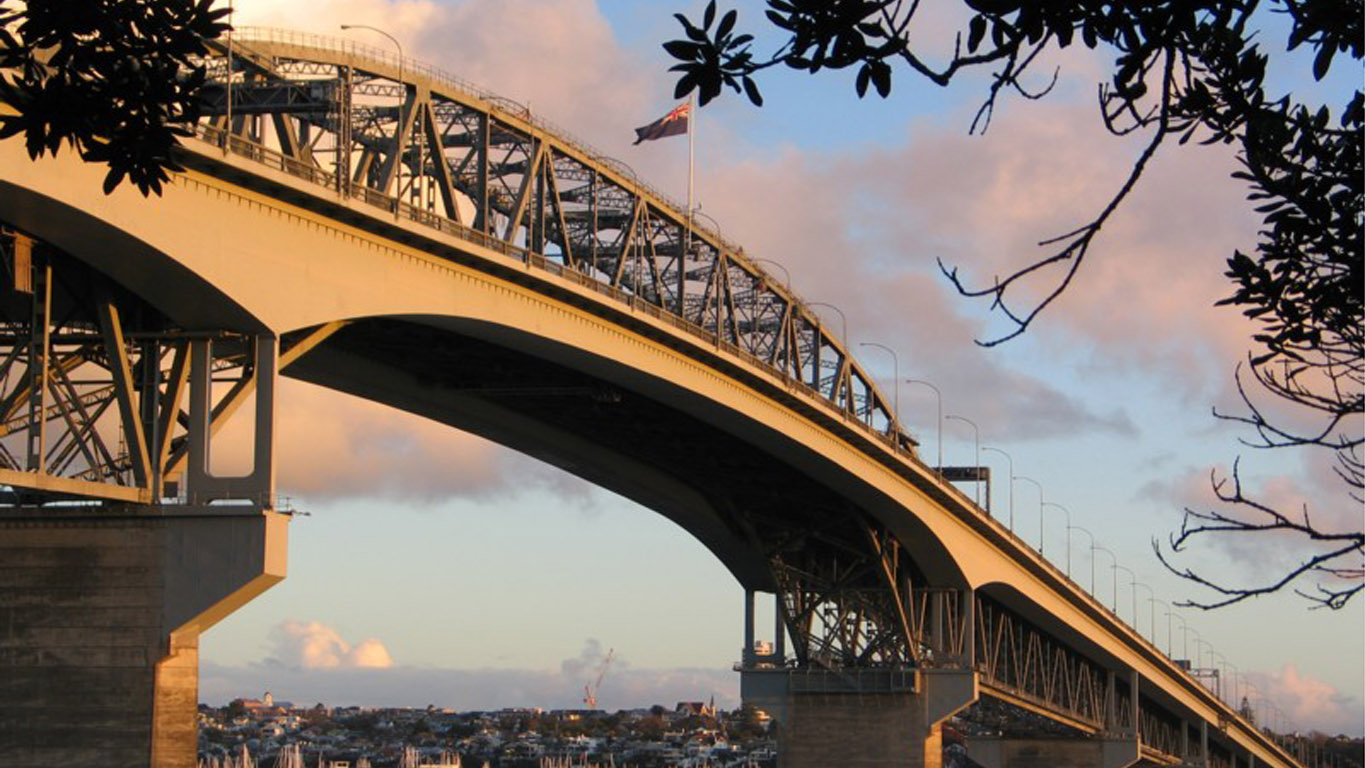This blog was originally written in 2016 and has been kept up-to-date over the years.
As we noted the other day, this year (indeed, this month and this week) marks a major anniversary: 70 years since the NZ government promised Auckland a fully walkable and bikeable harbour crossing. Auspiciously, 2016 also marks 40 years since a private advocate suggested the first solution for a retro-fitted pathway, thus kickstarting the process that led us to where we are now.
Longtime SkyPath supporter (and unofficial Cycle Action Auckland archivist) Kirsten Shouler has assembled the following timeline, so we can see how we got here – and who to thank!
1976 North Shore resident David Calvert proposes an underhung pathway for bikes suspended below the main carriageway. Despite major public interest in a bicycle crossing of any kind, the proposal is rejected by the Auckland Harbour Bridge Authority.
1979 Students undertake a protest ride across the AHB (as mentioned by Phil Robinson here).

1979 The PATH Campaign (Pathways Across The Harbour) campaigns for access shuttles instead, and a trial run far exceeds expectations. (A modified bus took over the service but broke down so often it was unreliable). Public support for ways to cross the bridge on bikes culminates in a bicycle rally up Queen St, asking the Auckland Regional Authority to provide bike racks on buses.

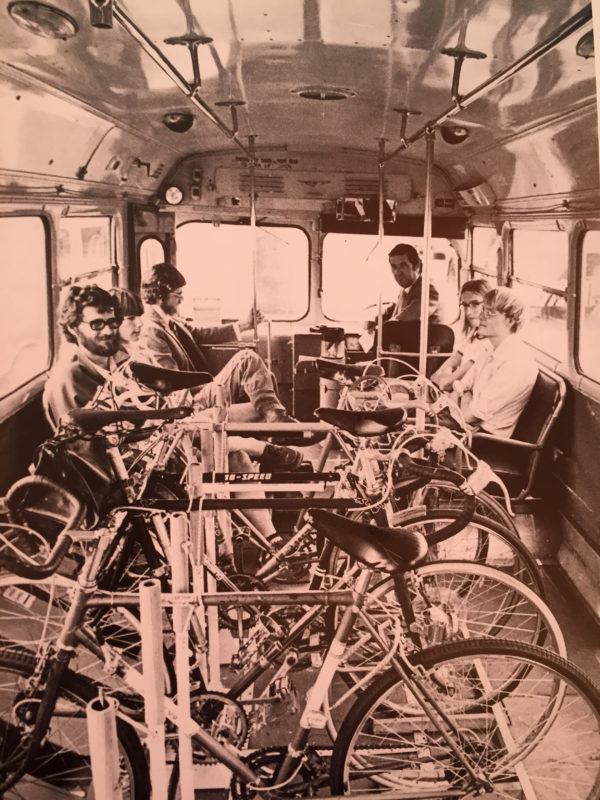
1980s and 1990s After the shuttle service ceases, lobbying largely goes quiet… but public enthusiasm for an AHB walking and cycling crossing never goes away.
1998 Cycle Action Auckland is formed, and over the next few years there’s a fresh push for a solution.
2003-2004 Graeme Knowles starts a petition to parliament which ultimately gathers around 6,700 signatures (no mean feat, in the days before widespread internet!).
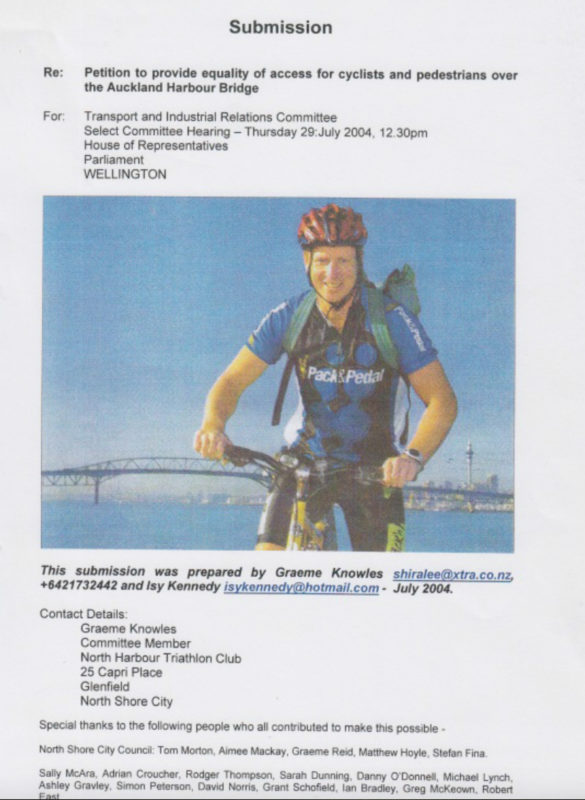
2004 The petition is presented to a Select Committee, which recommends a feasibility study by Transit NZ – to be delivered within a year.
2006 Cycle Action Auckland continues to lobby Transit NZ and Government, without success.
2007 Transit NZ finally delivers the feasibility report, and while the official decision is not to proceed, the agency agrees that bridge strengthening will allow for walking and cycling.
2008 Bevan Woodward launches the Getacross Campaign, gathering 12,000 supporters, motivated by the impending 50th anniversary of the bridge opening. (The hope was also to ‘blaze a pathway across Auckland Harbour Bridge in time for the 2011 Rugby World Cup’).
En route to a support rally in the city, there is a spontaneous crossing of the AHB by a group of cyclists from the north (including Judy Barfoot, staunch supporter of the campaign, then in her seventies – read her letter at the bottom of this column!).
2009 Demonstration of Support: more than 5,000 Aucklanders march across the AHB. The success of this march becomes a turning point for the campaign.
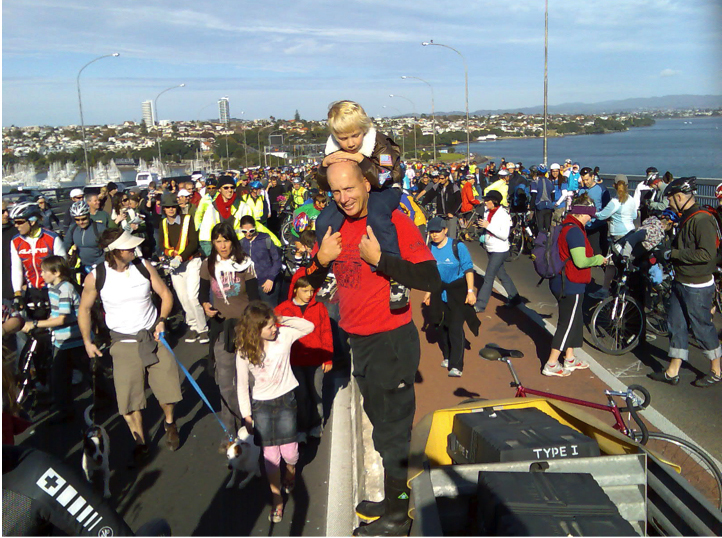
2010 The AHB Pathway Trust is formed by Bevan Woodward and others, to promote a private technical engineering solution and private funding proposal with a user-fee. Thanks to innovative private engineering concepts, the Trust progresses the design that will come to be known as SkyPath (based on Airey Consultants’ concept of a pathway structure hung under the eastern clip-on). NZTA agrees to permit SkyPath as a ‘community facility”, and Mayor Len Brown makes SkyPath one of his priorities for the Auckland SuperCity.
2011 NZTA reviews the design and agrees it is ‘a feasible engineering solution.’ Council sets up a steering group; Local Boards (Waitemata, Kaipatiki, Devonport-Takapuna) give their support in principle.
Initial concept designs are announced publicly in August 2011.
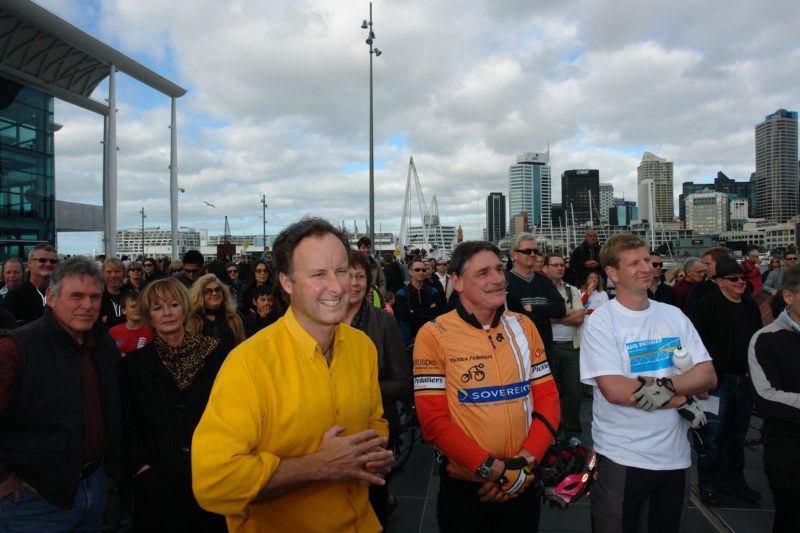
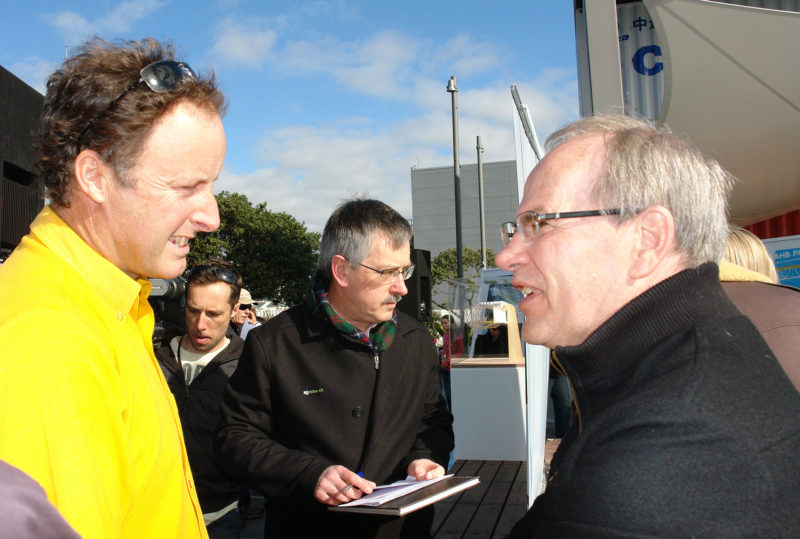
Bevan talks to Mayor Len Brown at the public launch, 2011.
2012 50th anniversary of the opening of the Auckland Harbour Bridge; NZTA confirms that SkyPath will be a Preferred Option.
2013 Auckland Council agrees to investigate SkyPath and the privately funded PPP solution offered by the PIP Fund.
2014-15 A revised design for SkyPath, using innovative lightweight composite materials.
SkyPath Resource Consent is lodged, following widespread consultation. More than 10,000 people make submissions – overwhelmingly in support of the proposal (as you can see on the amazing interactive map below, created by Timothy Duhamel; zoom out to see the big picture!).
Although Resource Consent is granted, residents’ groups at both ends of the bridge appeal the decision (as detailed in our previous update post).
2016 Work on the proposal over the past three years comes back before Auckland Council, which will consider recommending a green light for the PPP arrangement. You can read the agenda for that meeting (and plenty of background material) here.
And in August, NZTA’s Board will receive a report regarding a Licence to Occupy for Skypath.
Later this year, the Environment Court will continue hearing the appeal by the Northcote Residents’ Association (some background on their objections in this 2015 article in Metro).
Meanwhile, negotiations between Council and the PIP Fund, as well as with NZTA, will continue alongside further design work.
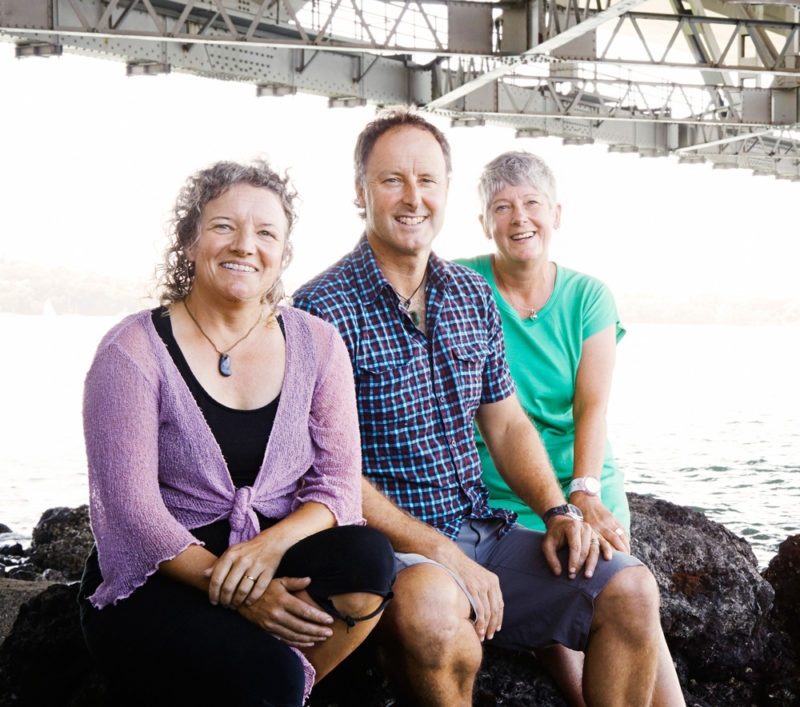
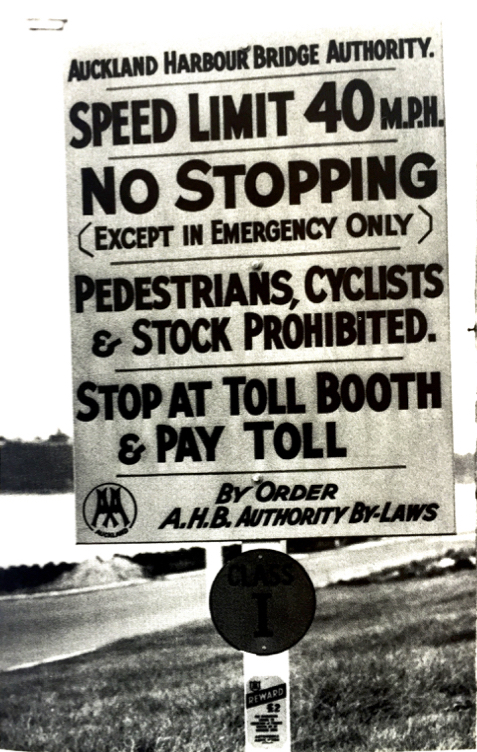
When we first published this blog in 2016, we forecasted that… “Once final agreements are signed next year, construction can begin. We’re optimistic – an opening date in late 2017 is a tangible possibility.”
What changed?
August 2018: Waka Kotahi’s Brett Gliddon and his team take responsibility for the Skypath project.
May 2019: Bike Auckland helps the team launch Waka Kotahi’s Skypath design.
February 2020: We welcomed NZ Upgrade funding of $240m for the project and $120m for Seapath to connect from the Bridge to Esmonde Rd.
August 2020: Bike Auckland is told that the Skypath Alliance team is working to resolve an issue of how the new structure is attached to the bridge piers.
November 2020: The project team leader presents to Bike Auckland’s AGM, advising that construction would begin in 2021, with completion in 2024. We concluded from this that WK’s 2019 design was on track.
December 2020: While there has been no public announcement or confirmation, we are led to understand that the 2019 design for Waka Kotahi’s ‘Skypath II’ has been abandoned and investigations are underway on a new design. The details of this are under wraps, including when it will be revealed to the public.
February 2021: Fullers’ ferries serving Devonport prevent people commuting by ferry with bikes in peak hours because of congested deck space. Bike Auckland alerts WK and AT to the issue, and asks for an urgent meeting to plan alternatives. A joint meeting was convened with Fullers and AT. Waka Kotahi failed to attend.
March 2021: It is announced that Waka Kotahi’s Skypath is probably cancelled. Bike Auckland contacts Waka Kotahi in a formal letter withdrawing our support for their management of Skypath. We ask for urgent transparency, and for Waka Kotahi to liberate the lane on the Harbour Bridge to cater for cross-harbour travel with bikes until the purpose built structure is opened.
April 2021: Bike Auckland meets the Minister of Transport, Michael Woods, asking him to encourage Waka Kotahi to collaborate with Bike Auckland to establish a 3 month trial this summer (in January, February and March) to convert one lane of the AHB to provide cycling connectivity between Northcote and Westhaven.
May 2021: Bike Auckland hold a Liberate the Lane rally with estimated 2500 people in attendance. Waka Kotahi announces a plan for a new walking and cycling bridge across the Harbour.
September 2021: The plan for the new walking and cycling bridge is scrapped, presumably due to lack of public support.
November 2022: Waka Kotahi seek feedback about a potential new crossing of the Waitematā Harbour.
March 2023: Waka Kotahi releases 5 potential options for a new crossing of the Waitematā Harbour which include access for all modes (including light rail). Bike Auckland appreciates that there is access for walking and cycling in these designs but they will take 10 – 20 years to be completed. Bike Auckland pushes for an interim solution such as liberating a lane on the existing bridge for walking and cycling.
July 2023: Bike Auckland released a report by Smartsense Ltd. which confirms that repurposing a lane on the Auckland Harbour Bridge is viable, safe, and would have minimal impact on traffic flows. Alongside this, the Liberate the Lane webpage is launched, including an open letter and showcasing the broad range of organisations and businesses which support the call to liberate the lane.

